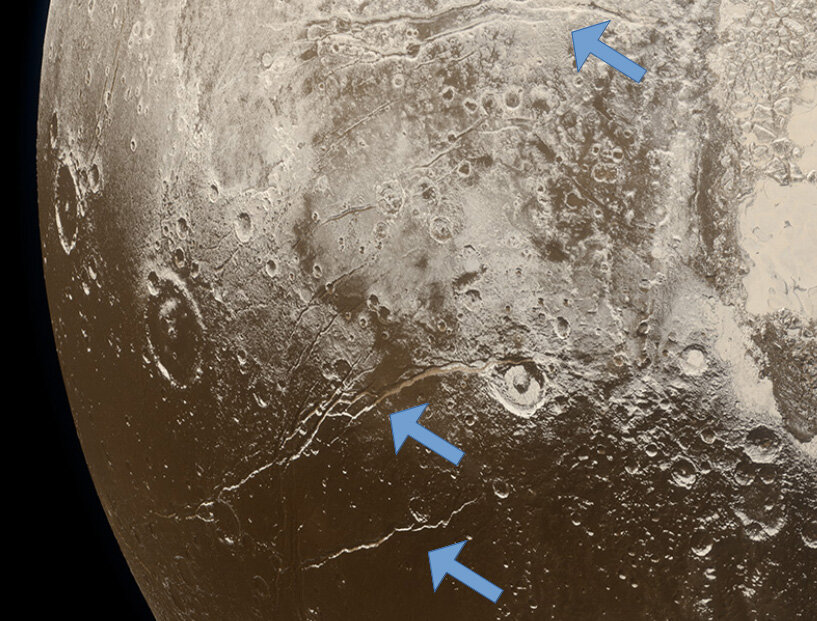

Extensive faults (arrows) on Pluto’s surface indicate the expansion of the dwarf planet’s icy crust, attributed to the freezing of a subsurface ocean. Credit: NASA / Johns Hopkins University Applied Physics Laboratory / Southwest Research Institute / Alex Parker
The accumulation of new material during the formation of Pluto may have generated enough heat to create a liquid ocean that has persisted under an icy crust to this day, despite the dwarf planet’s orbit away from the sun in the cold reaches of the solar system.
This “hot start” scenario, featured in an article published June 22 in Nature Geoscience, contrasts with the traditional view of Pluto’s origins as a frozen ball of ice and rock in which radioactive decay could have generated enough heat to melt the ice and form a subsurface ocean.
“For a long time, people have thought about Pluto’s thermal evolution and the ability of an ocean to survive to this day,” said co-author Francis Nimmo, professor of Earth and planetary science at the University of California, Santa Cruz. . “Now that we have images of Pluto’s surface from NASA’s New Horizons mission, we can compare what we see with predictions from different models of thermal evolution.”
Because water expands when it freezes and contracts when it melts, the hot and cold start scenarios have different implications for tectonics and the resulting surface characteristics of Pluto, explained the first author and graduate student at UCSC. , Carver Bierson.
“If it started to cool and the ice melted internally, Pluto would have contracted and we should see compression characteristics on its surface, whereas if it started to heat up it should have expanded as the ocean froze and we should see extension characteristics in the surface, “Bierson said. “We see a lot of evidence of expansion, but we don’t see evidence of compression, so the observations are more consistent with Pluto starting with a liquid ocean.”
The thermal and tectonic evolution of a cold-start Pluto is actually a bit tricky, because after an initial period of gradual melting, the subsurface ocean would begin to freeze again. Therefore, compression of the surface would occur initially, followed by a more recent extension. With a warm start, the expansion would occur throughout Pluto’s history.
“The older surface features on Pluto are more difficult to understand, but it appears there was an ancient and modern extension of the surface,” said Nimmo.
The next question was whether there was enough energy available to give Pluto a good start. The two main sources of energy would be the heat released by the decomposition of radioactive elements in the rock and the gravitational energy released as the new material bombarded the surface of the growing protoplanet.
Bierson’s calculations showed that if all gravitational energy were retained as heat, it would inevitably create an initial liquid ocean. However, in practice, much of that energy would radiate away from the surface, especially if the build-up of new material occurs slowly.
“How Pluto formed in the first place is very important to its thermal evolution,” said Nimmo. “If it accumulates very slowly, the hot material on the surface radiates energy into space, but if it accumulates quickly enough, the heat is trapped inside.”
The researchers calculated that if Pluto formed in a period of less than 30,000 years, then it would have started hot. If, instead, the accumulation took place over a few million years, a warm start would only be possible if the large impactors buried their energy below the surface.
The new findings imply that other large objects in the Kuiper Belt likely started hot as well and may have had early oceans. These oceans could persist to this day on larger objects, such as the dwarf planets Eris and Makemake.
“Even in this cold environment so far from the sun, all of these worlds could have formed hot and fast, with liquid oceans,” Bierson said.
In addition to Bierson and Nimmo, the document was written by Alan Stern at the Southwest Research Institute, the principal investigator for the New Horizons mission.
The ammonia detected on Pluto’s surface hints at groundwater.
Evidence of a hot start and early ocean formation on Pluto, Nature Geoscience (2020). DOI: 10.1038 / s41561-020-0595-0, www.nature.com/articles/s41561-020-0595-0
Provided by the University of California – Santa Cruz
Citation: Evidence supports ‘hot start’ scenario and early ocean formation on Pluto (2020, June 22) retrieved on June 23, 2020 from https://phys.org/news/2020-06-evidence- hot-scenario-early-ocean.html
This document is subject to copyright. Other than fair dealing for private research or study purposes, no part may be reproduced without written permission. The content is provided for informational purposes only.